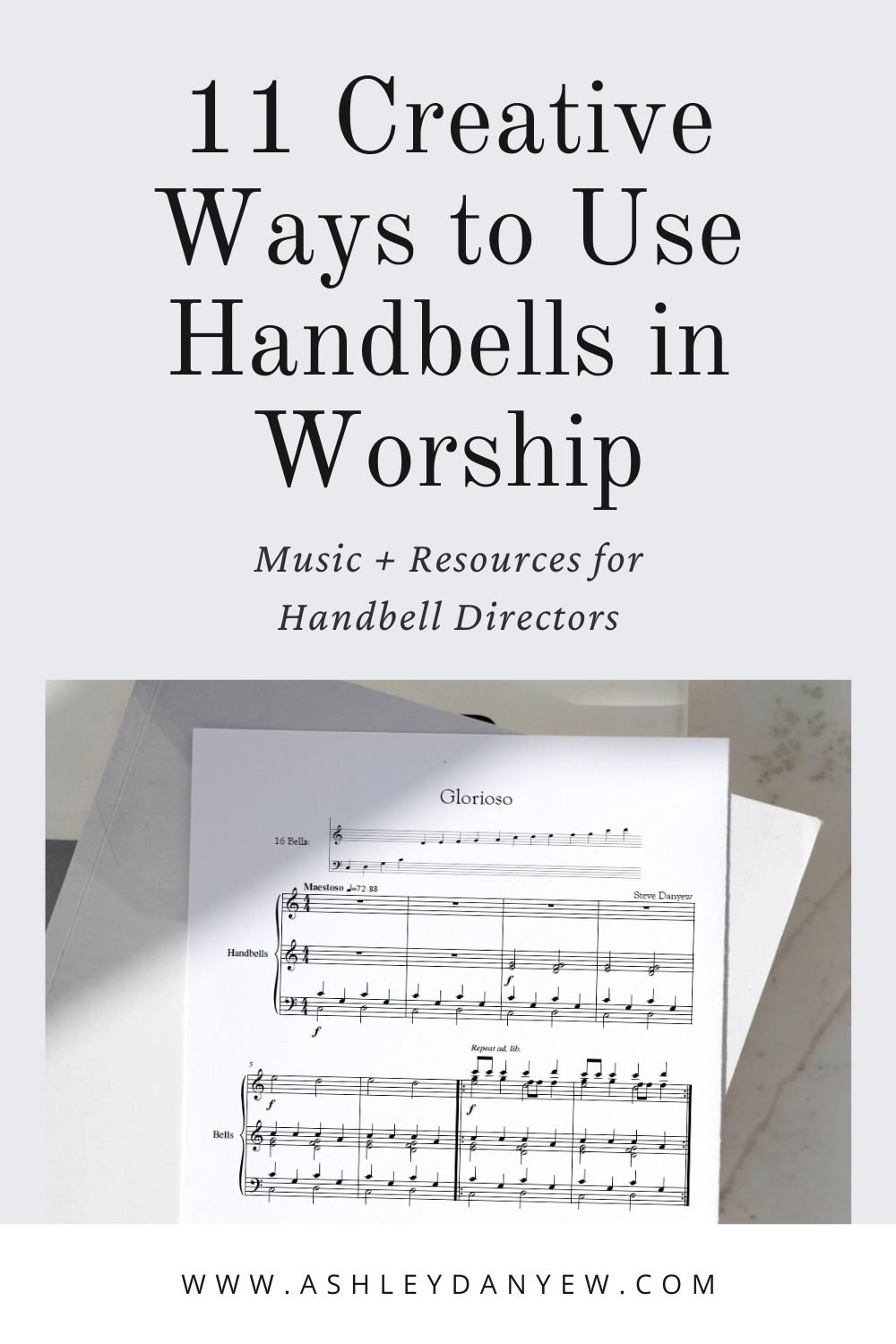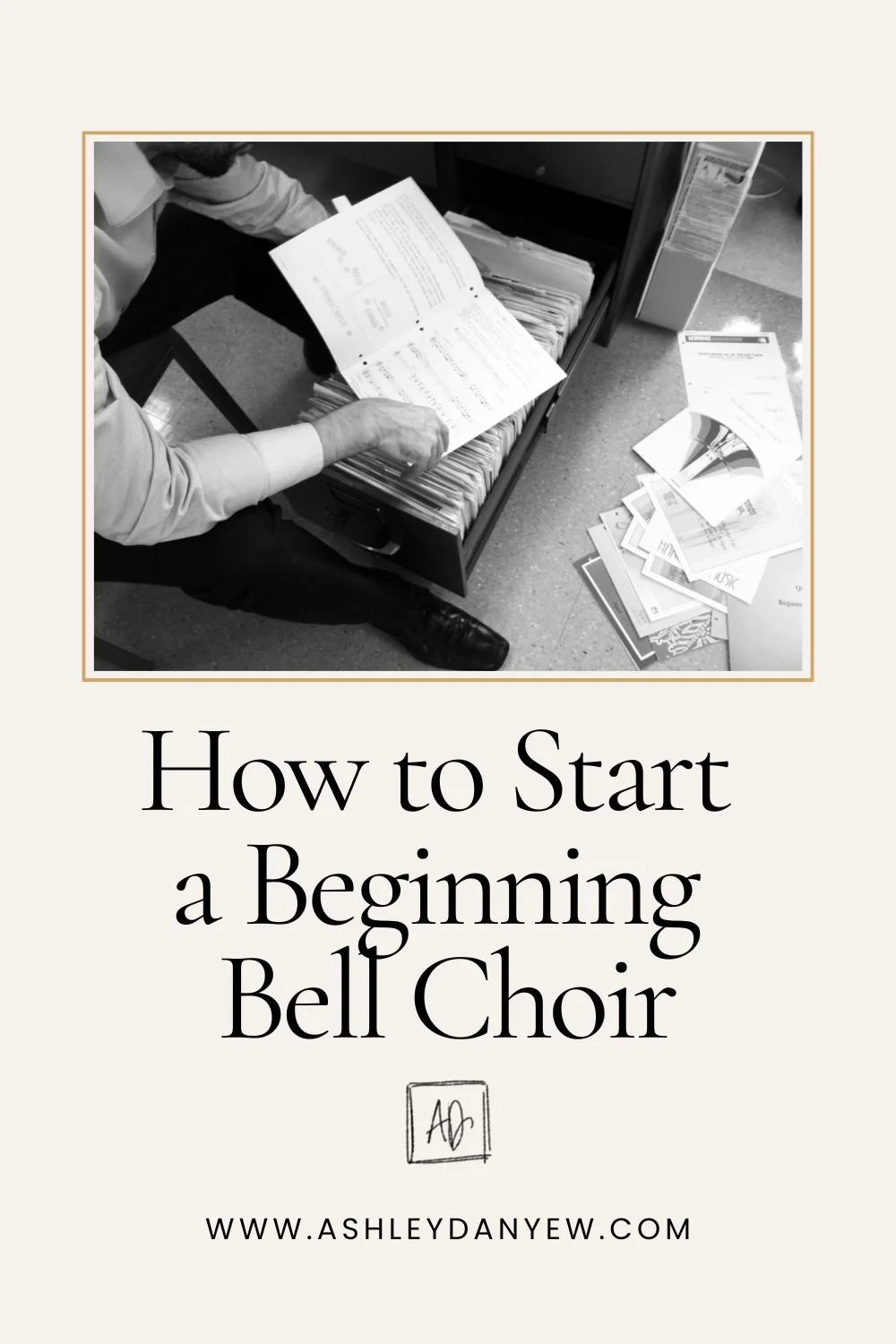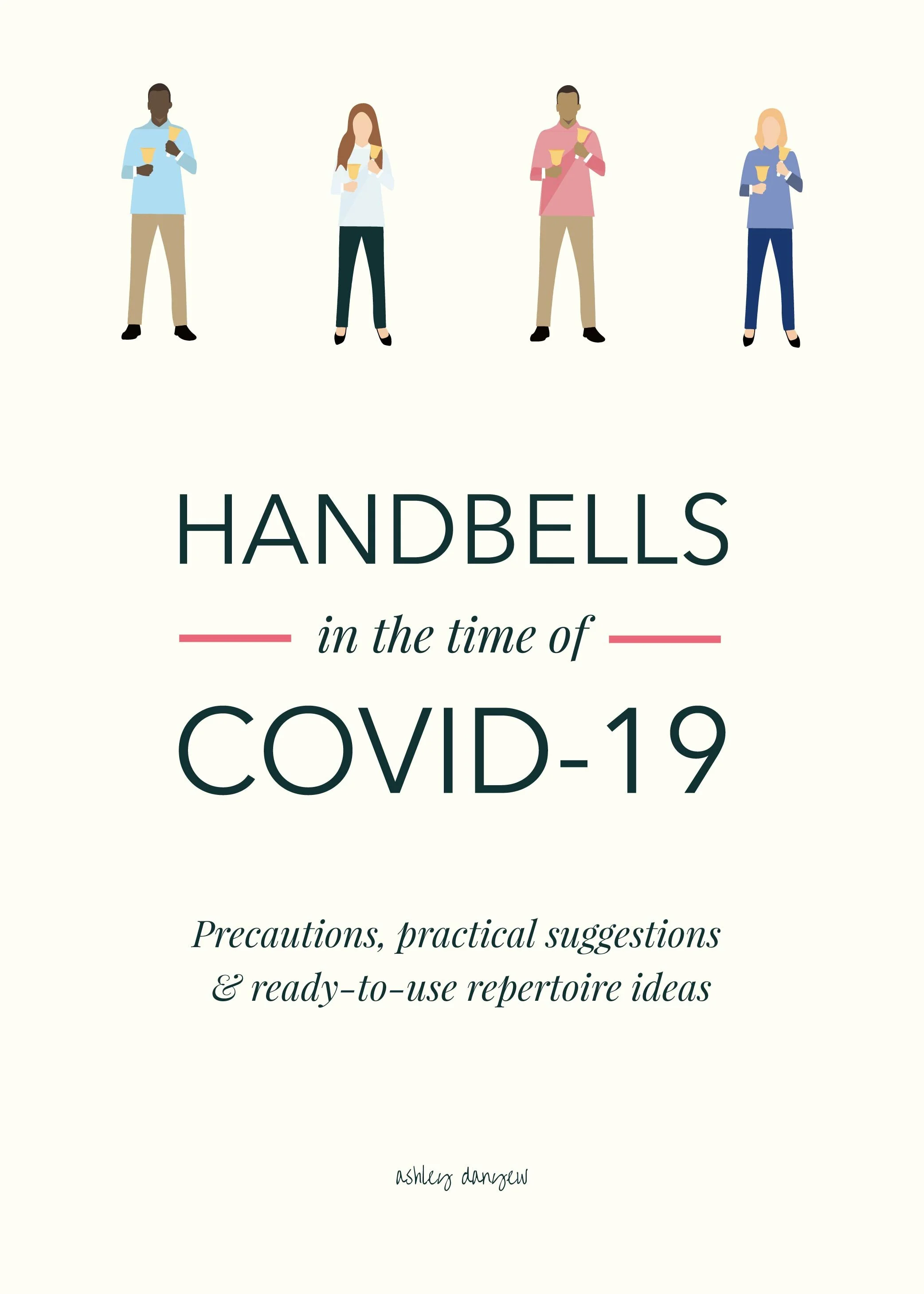One of the most creative parts of worship planning is finding unique ways to incorporate music into your services. From introits to benediction responses, prayer responses, moments of transition, and even underscoring.
Handbells are a great way to do this!
When I directed bell choirs, I loved coming up with creative, meaningful ways to include handbells in worship, beyond the traditional prelude or anthem slot.
Maybe you recently inherited a bell choir at your church and are looking for some creative, out-of-the-box ideas for your group this year.
Or maybe you’re starting a new bell choir from scratch and looking for ways to get started using handbells in worship.
Who said you have to have tables and foam and covers, special folders and notebook stands to play? I’m here to say you can break with tradition and use handbells in a whole new way.
In this post, I'm sharing 11 creative ways to use handbells in worship. Enjoy!
11 New Ideas for Using Handbells in Worship
*Disclosure: I get commissions for purchases made through links in this post.
No. 1 - Bell Processional
Process into the sanctuary playing a simple acclamation—something made of repeated patterns (1-2 measures in length) that can be learned quickly and played from memory and repeated as needed (like this one).
For added effect, process into the sanctuary, gradually adding parts, then walk back out, gradually taking parts away (works well during more reflective services or during Lent).
Here are a few collections to consider:
Processionals for the Time of Lent (Barbara Semmann) - 5 octaves
Processionals for the Time of Easter (Barbara Semmann) - 5 octaves
Processionals for the Day of Pentecost (Barbara Semmann) - 5 octaves
Four Easy Handbell Processionals (arr. Michael Burkhardt) - 3 octaves
Processionals for Handbells (John Behnke) - 3-5 octaves
Hymn Processionals for Handbells (arr. Hefner) - 3 octaves
Three Processionals for Handbells and Chimes (Downey) - 3-5 octaves
Well-Tempered Handbell Processionals (arr. Charles E. Peery) - 2-3 octaves or 4-5 octaves
Six Processionals (Sandra Eithun) - 3-5 octaves
Four Pieces for Advent, Christmas, Epiphany, Lent, Easter, and Pentecost (my own collections!) - 2-5 octaves (12-21 bells)
Five Processionals (Ashley Danyew) - 3-5 octaves (11-12 bells)
Need something for a smaller group/fewer bells? Create your own with this helpful step-by-step guide:
Related post: How to Write Your Own Handbell Processional
No. 2 - Chiming the Hour
This is a simple, but effective way to incorporate bells in worship. Use a mid-range bell around C5 to chime the hour at the beginning of the service (ring slow whole notes).
No. 3 - Bell Toll with Scripture Reading
This works well with Psalms, stories, parables, and other longer readings that have natural pauses. It’s also very effective for somber readings such as The Passion Narrative and the Seven Last Words of Christ.
Use a mid-range bell, such as E4 or G4, and have one person stand at the front, to the side of the lectern or pulpit (wherever the reader stands). You might also consider using a bell toll in other parts of the service—during the prayers of the people, on All Saints’ Day in remembrance of those lost, etc.
Related post: Sing with the Saints: Worship Planning for All Saints’ Day
No. 4 - Singing Bell Underscore
The singing bell is a perfect way to add a subtle yet moving underscore to your worship service.
In case this technique is new to you, here’s a quick video tutorial. Use a singing bell to underscore a Scripture reading (I’ve done this on Christmas Eve for the Luke 2 reading and on Easter morning with the "Reading from the Tomb" and it was very effective!), a creed, or a responsive reading. Depending on the context, you might also consider adding soft, sustained piano chords.
To underscore a reading:
Step 1. Choose 3-4 bells (e.g. A3, G4, C5, D5).
Step 2. Divide the reading into paragraphs (several sentences each). It takes a little time to get the bell to start singing, so consider starting the motion before the reading begins and give yourself plenty of time to get a new bell going partway through the reading.
Step 3. Remember, each player can only play one bell at a time when using the singing bell technique. I recommend having at least two people if not three underscore a reading. That way, you can overlap the bells, so as one person is starting a new bell, there are 1-2 others already sounding.
Step 4. Play around with different clusters of notes and choose particular parts of the reading to highlight with a sonority change, if desired.
Related post: How to Use Handbells to Underscore a Reading
No. 5 - Responses
Play a familiar hymn (try reading the parts straight from the hymnal!) or use a prayer response that gradually builds from one part (symbolizing our prayers as individuals) to many (our collective prayers), like Lenten Processional.
You could also play a short benediction response from the back of the church (or balcony, if you have one). Try a choral three-fold Amen, or choose something from your hymnal.
Free Resource
Wondering what that symbol means?
Wonder no more. This handy, printable handbell notation guide includes the symbols you see in the score plus directions on how to play them. Print one for yourself and enough for your ringers to keep a copy in the back of their folders.
No. 6 - Play in the Aisles
Again, who said you have to play behind tables? Instead, choose a piece that requires only two bells per player (here are some ideas) and ring from music stands set up in the side aisles (or anywhere, really).
Related post: 50 Pieces for the Small Handbell Choir
No. 7 - Hymn Accompaniments
Handbells are a wonderful addition to hymns, especially when they can ring a simple peal or ostinato pattern or create a random ring effect. Here are a few suggestions:
Peals (C5-C7):
Joy to the World (Antioch)
Christ the Lord Is Risen Today (Easter Hymn)
Rejoice, the Lord Is King (Darwall’s 148th)
O Worship the King (Lyons)
Come, Christians, Join to Sing (Madrid)
Come, Thou Almighty King (Italian Hymn)
You can also use a handbell peal before the hymn introduction, as a transition into the last verse, or as a brief coda as the congregation holds the final note.
Another idea is to use it to underscore a joyful Psalm reading, such as Psalm 100.
Random Ring (4-6 bells, A4-C6):
How Firm a Foundation (Foundation)
Lord, Whose Love Through Humble Service (Beach Spring)
Come, Holy Ghost, Our Souls Inspire (Veni Creator Spiritus)
O Come, O Come, Emmanuel (Veni Emmanuel)
Of the Father’s Love Begotten (Divinum Mysterium)
Creator of the Stars of Night (Conditor Alme Siderum)
Be Thou My Vision (Slane)
This Is My Father’s World (Terra Beata)
Immortal, Invisible (St. Denio)
O Sing a Song of Bethlehem (Kingsfold)
Open 5ths:
Use a simple, plaintive open 5th (the first and fifth note of the scale, played together) to accompany pentatonic, meditative, or plainsong hymns, or hymns with a strong duple or compound meter pulse. Play the open 5th before each phrase and at the end of the last phrase and let ring (do not damp). Use a 5th in the treble range or bass range:
Treble (G4-C6):
Go to Dark Gethsemane (Redhead 76)
Jesus Walked This Lonesome Valley (Lonesome Valley)
Were You There? (Were You There)
Amazing Grace (New Britain)
Let All Mortal Flesh Keep Silence (Picardy)
What Wondrous Love Is This (Wondrous Love)
Bass (F3-G4):
How Firm a Foundation (Foundation)
All Things Bright and Beautiful (Royal Oak)
Come, Christians, Join to Sing (Madrid)
Jesus Walked This Lonesome Valley (Lonesome Valley)
Good Christian Friends, Rejoice (In Dulci Jubilo)
O Sing a Song of Bethlehem (Kingsfold)
We Gather Together (Kremser)
Once In Royal David's City (Irby)
No. 8 - Psalter Response
The Psalter is a great way to include the Psalm of the Day in your worship service and promote congregational participation. Each psalm is comprised of two main parts—the psalm text, which may be chanted or spoken, responsively or not—and a sung musical refrain, often with text drawn from the psalm.
Musical refrains (or antiphons) may be sung at the beginning of the psalm and at the end of each stanza. This is often indicated by a red R in the text. (source)
This document includes ostinati accompaniments for all eight psalm tones and 35 psalter responses, as written in the UMH (up through Psalm 32). Many of these accompaniments are playable by just a few ringers - sometimes, just one person. I think this would be particularly effective during Advent or Lent.
Alternatively, you could pair a psalm with a related hymn or song—something from your hymnal or supplement.
Related post: Singing the Psalms: A Guide for Modern Worship
No. 9 - Bell Tree with Solo Instrument
Multiple handbells can be played at once when made into a bell tree. In a bell tree, “[the] handles are interlaced within each other, allowing multiple bells to be played with mallets to obtain an undamped sound” (source). This effect would work well as a sparse accompaniment for hymns like:
What Wondrous Love Is This (Wondrous Love)
Were You There? (Were You There)
Of the Father’s Love Begotten (Divinum Mysterium)
Let All Mortal Flesh Keep Silence (Picardy)
No. 10 - Harmonic Accompaniment with Solo (Vocal or Instrumental)
This is a great way to give your beginning handbell group an opportunity to play early in the year. The bells provide a simple harmonic accompaniment while a vocal or instrumental soloist (flute, violin, oboe, clarinet, saxophone, etc.) plays the melody. This would work well with simple, folk-like hymns such as:
Amazing Grace (New Britain)
What Wondrous Love Is This (Wondrous Love)
Simple Gifts (Simple Gifts)
I Surrender All (Weeden)
Be Thou My Vision (Slane)
No. 11 - Transition Music
As someone who contributes to worship planning, you know there are always times of transition in the service: before and after Children’s Time, as the choir gets into place on the chancel steps, as the pastor moves to the Communion table, etc.
This is a great time to play a short musical interlude with handbells.
Use one of the processionals listed under No. 1 and ad-lib to match the length of the transition in your service.
Want to become a more creative, confident director?
Join me in Music Education & Leadership Skills for the Handbell Choir Director, a mini online training course just for handbell choir directors.
This course will help you develop valuable teaching skills and equip you with the practical tools and skills you need to lead and teach your handbell choir with creativity and confidence. I’d love to have you join me!
A Few Helpful Resources:
The Creative Use of Handbells in Worship - Vol. 1 (Hopson)—innovative ideas for handbells, from a single bell to a full bell choir (includes reproducible parts)
The Creative Use of Handbells in Worship - Vol. 2 (Hopson)—this volume focuses on creative ideas for using 4-6 bells in worship (includes reproducible parts)
A Practical Guide to Arranging Music for Organ, Choir, Handbells, and Other Instruments (Hopson)—lots of useful ideas for incorporating bells and other instruments in worship, descants, hymn accompaniments (all reproducible), and practical ways to create custom arrangements for the players in your church
More Creative Ways to Use The Choir, Organ, Handbells, and Other Instruments in Worship (Hopson)—100+ ideas for your worship services, with reproducible parts for your choirs and instrumentalists
I’d love to hear from you:
What are your favorite ways to use handbells in worship?






















![Handbell Notation Guide [Infographic]](https://images.squarespace-cdn.com/content/v1/585c710603596e2c47dad93e/1491403915874-P2UH6FM8J1W1HM4UWP17/Handbell+Notation+Guide-02.png)


![The Joy of Children's Handbell Choirs [Video]](https://images.squarespace-cdn.com/content/v1/585c710603596e2c47dad93e/1482458472572-UQOTZ604Q6UKSIBZVYEZ/image-asset.png)










